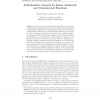1805 search results - page 77 / 361 » Functional programming with structured graphs |
SAS
2004
Springer
14 years 4 months ago
2004
Springer
We describe data structures and algorithms for performing a path-sensitive program analysis to discover equivalences of expressions involving linear arithmetic or uninterpreted fun...
IFL
1997
Springer
14 years 2 months ago
1997
Springer
Common subexpression elimination is a well-known compiler optimisation that saves time by avoiding the repetition of the same computation. In lazy functional languages, referential...
ICFP
1998
ACM
14 years 2 months ago
1998
ACM
In this paper we explain how recursion operators can be used to structure and reason about program semantics within a functional language. In particular, we show how the recursion...
LCTRTS
2007
Springer
14 years 4 months ago
2007
Springer
Existing methods place data or code in scratchpad memory, i.e., SPM by either relying on heuristics or resorting to integer programming or mapping it to a graph coloring problem. ...
TCS
2008
13 years 10 months ago
2008
The replication number of a branching program is the minimum number R such that along every accepting computation at most R variables are tested more than once; the sets of variab...

